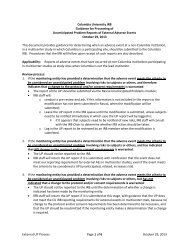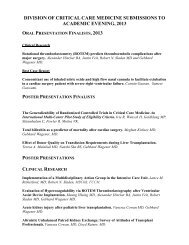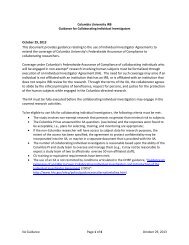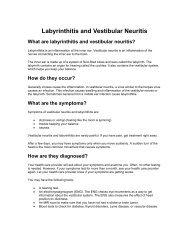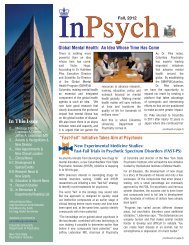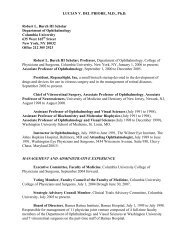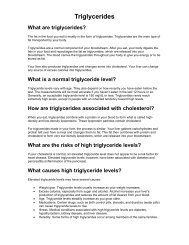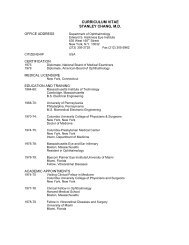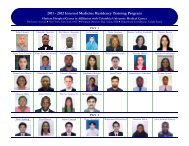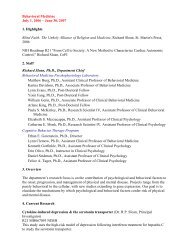news PS - Columbia University Medical Center
news PS - Columbia University Medical Center
news PS - Columbia University Medical Center
Create successful ePaper yourself
Turn your PDF publications into a flip-book with our unique Google optimized e-Paper software.
The following year, 2009, many centers around the world began to try<br />
ECMO. They turned to it in desperation as the H1N1 pandemic hit, causing<br />
a severe form of ARDS – acute respiratory distress syndrome – particularly<br />
in young people. Around the same time, a major randomized controlled<br />
trial appeared to show benefit. With those two events, ECMO use took off.<br />
<strong>Columbia</strong> now treats around 100 adults a year with ECMO. Among<br />
those treated with ECMO for respiratory failure, the most common<br />
indications are ARDS, bridge to lung transplant, and asthma. An IRBapproved<br />
study protocol also allows for the treatment of some patients<br />
with acute exacerbations of chronic obstructive pulmonary disease. The<br />
team has pioneered the use of lower levels of anticoagulation and has<br />
lowered the amount of blood transfused, which reduces complications.<br />
In most patients with respiratory failure, a single cannula placed in the neck<br />
has replaced a two-cannula system that typically included one in the groin.<br />
This has been particularly beneficial for patients awaiting lung transplantation<br />
who experience acute respiratory failure. Such patients would frequently<br />
“sit on a ventilator for a number of days not moving and would become too<br />
deconditioned to get transplanted. If donated lungs did not become available<br />
before this point they would be removed from the transplant list,” Dr. Brodie<br />
Integrated Arthritis <strong>Center</strong>: Applying Research to Patient Care<br />
By Andrea Crawford<br />
<strong>Columbia</strong> <strong>University</strong>’s new Integrated Arthritis <strong>Center</strong> is one of only a<br />
few centers in the country that integrate research directly into patient care<br />
activity, says Joan Bathon, M.D., professor of medicine-rheumatology<br />
and medical director of the center.<br />
The center offers a full-service approach to treating patients with<br />
osteoarthritis, rheumatoid arthritis, and other inflammatory diseases, for<br />
which neither cause nor cure is known. It features an injection clinic using<br />
ultrasound guidance, technology useful in targeted treatment, particularly<br />
in challenging small joints, such as wrists, shoulders, and ankles, but<br />
also useful as a research tool. “It’s helped us to understand how much<br />
under-the-surface swelling there can be without us being able to feel it,”<br />
says Dr. Bathon, who was recruited to P&S to head the rheumatology<br />
division in the Department of Medicine. The center collaborates with biomedical<br />
engineers to investigate new methods for optical imaging, which<br />
could improve existing technologies that provide information such as the<br />
amount of oxygenation or blood flow present in joints.<br />
Dr. Bathon’s own research in the care of inflammatory and degenerative<br />
arthritis focuses on the cardiovascular effects of rheumatoid arthritis.<br />
Previously director of the Johns Hopkins Arthritis <strong>Center</strong>, Dr. Bathon has<br />
found that patients with rheumatoid arthritis have accelerated atherosclerosis<br />
and reduced heart mass, suggesting silent muscle damage or loss<br />
of myocytes. With collaborators on several NIH-funded projects, she is<br />
looking for a genetic marker in rheumatoid arthritis to indicate those at<br />
risk for the accelerated form of atherosclerosis in RA as well as attempting<br />
to identify a protein bio(multi)marker for the same purpose through<br />
says. With single-cannula ECMO, patients have been able to get off the ventilator<br />
completely, talk, eat, and in some cases exercise to remain in shape for<br />
a transplant, which allows them to wait longer for the arrival of donor lungs.<br />
The center is one of a few in the United States to use a mobile ECMO<br />
unit, which enables the team to stabilize patients with ECMO before<br />
transferring them to CUMC. The mobile unit recently became equipped<br />
to conduct transfers by flight. The mobile technology isn’t much different<br />
from standard ECMO, Dr. Brodie says, “but you need a high level of<br />
comfort with ECMO to run it in a parking lot.” Dr. Bacchetta, an officer<br />
in the U.S. Army Reserves with extensive experience in frontline trauma<br />
care (including the use of ECMO during his last tour in Afghanistan),<br />
standardized the equipment and protocols for ECMO transfers.<br />
As significant as EMCO is for patients today, its most important application<br />
may be the role it will play in the evolution of an actual artificial lung implanted<br />
in the body. “There are prototypes out there already,” Dr. Bacchetta says. Artificial<br />
lung devices, he believes, could be ready for patients within the decade.<br />
To transfer a patient to the <strong>Center</strong> for Acute Respiratory Failure, physicians<br />
may call 1-800-NYP-STAT (the Access Transfer <strong>Center</strong>) 24/7.<br />
proteomic screens of inflammatory, endothelial, and other relevant soluble<br />
molecules. She and collaborators are also investigating whether the<br />
protein modification called citrullination – one of the major ways rheumatoid<br />
arthritis patients develop antibodies – occurs in and potentially is<br />
responsible for damaging heart muscle.<br />
The advantages of being treated in an integrated center are many, says Dr.<br />
Bathon. “When presented right there with options to participate in research<br />
studies, whether it involves treatment or a non-treatment study, patients<br />
respond very enthusiastically.” Self-interest is obviously part of the appeal<br />
but, she adds, “frequently they are motivated out of a more global interest,<br />
that is, how will the knowledge gained in the study contribute in the long run<br />
to helping others with the same illness? This gives them a lot of personal satisfaction.”<br />
Research participation also gives patients extra attention through<br />
educational forums that keep study participants informed about outcomes.<br />
Seamless integration of research and clinical care is also the goal for other<br />
multidisciplinary collaborations. Dr. Bathon’s plans, including a center for<br />
lupus research, draw expertise from rheumatology, nephrology, dermatology,<br />
and obstetrics. She also is developing an autoimmune interstitial lung<br />
disease center and hopes to establish a cardiovascular risk management clinic<br />
with cardiac and metabolic experts. “For good clinical research, it is important<br />
to have a divisional culture with a strong commitment to research,” she<br />
says, to enable clinical and translational research to net new discoveries that<br />
lead to diagnostic and treatment tools to improve health.<br />
More information is available by calling 212-305-4308.<br />
Spring 2012 <strong>Columbia</strong>Medicine 15



